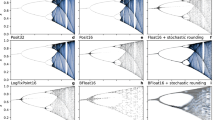Abstract
An improved parallel multiple-precision Taylor (PMT) scheme is developed to obtain clean numerical simulation (CNS) solutions of chaotic ordinary differential equations (ODEs). The new version program is about 500 times faster than the reported solvers developed in the MATHEMATICA, and also 2–3 times faster than the older version (PMT-1.0) of the scheme. This solver has the ability to yield longer solutions of Lorenz equations [up to 5000 TU (time unit)]. The PMT-1.1 scheme is applied to a selection of chaotic systems including the Chen, Rossler, coupled Lorenz and Lü systems. The T c -M and T c -K diagrams for these chaotic systems are presented and used to analyze the computation parameters for long-term solutions. The reliable computation times of these chaotic equations are obtained for single- and double-precision computation.





Similar content being viewed by others
References
Hammel SM, Yorke JA, Grebogi C (1987) Do numerical orbits of chaotic dynamical processes represent true orbits? J Complex 3:136–145
Nusse HE, Yorke JA (1988) Is every approximate trajectory of some process near an exact trajectory of a nearby process? Commun Math Phys 114:363–379
Sauer T, Yorke JA (1991) Rigorous verification of trajectories for the computer simulation of dynamical systems. Nonlinearity 4:961
Ansov D (1969) Geodesic flows on closed riemannian manifolds with negative curvature. In: Proceedings of the Steklov Institute of Mathematics
Sauer T, Grebogi C, Yorke JA (1997) How long do numerical chaotic solutions remain valid? Phys Rev Lett 79:59–62
Li JP, Zeng QC, Chou JF (2000) Computational uncertainty principle in nonlinear ordinary differential equations-I. Numerical results. Sci China Ser E Tech Sci 43:449–461
Li JP, Zeng QC, Chou JF (2001) Computational uncertainty principle in nonlinear ordinary differential equations-II. Theoretical analysis. Sci China Ser E Tech Sci 44:55–74
Lorenz EN (2006) Computational periodicity as observed in a simple system. Tellus A 58:549–557
Teixeira J, Reynolds CA, Judd K (2007) Time step sensitivity of nonlinear atmospheric models: numerical convergence, truncation error growth, and ensemble design. J Atmos Sci 64:175–189
Liao SJ (2009) On the reliability of computed chaotic solutions of non-linear differential equations. Tellus A 61:550–564
Li J, Wang S (2008) Some mathematical and numerical issues in geophysical fluid dynamics and climate dynamics. Commun Comput Phys 3:759–793
Shi P (2008) A relation on round-off error, attractor size and its dynamics in driven or coupled logistic map system. Chaos 18:013122
Brent RP (1978) A Fortran multiple-precision arithmetic package. ACM Trans Math Softw (TOMS) 4:57–70
Oyanarte P (1990) MP-a multiple precision package. Comput Phys Commun 59:345–358
Wang PF, Huang G, Wang ZZ (2006) Analysis and application of multiple-precision computation and round-off error for nonlinear dynamical systems. Adv Atmos Sci 23:758–766
Moore RE (1966) Interval analysis. Prentice-Hall, Englewood Cliffs New Jersey
Moore RE (1979) Methods and applications of interval analysis. SIAM, Philadelphia
Barrio R (2005) Performance of the Taylor series method for ODEs/DAEs. Appl Math Comput 163:525–545
Liao SJ (2013) On the numerical simulation of propagation of micro-level inherent uncertainty for chaotic dynamic systems. Chaos Soliton Fract 47:1–12
Liao S (2014) Physical limit of prediction for chaotic motion of three-body problem. Commun Nonlinear Sci Numer Simul 19:601–616
Barrio R, Rodríguez M, Abad A et al (2011) Breaking the limits: the Taylor series method. Appl Math Comput 217:7940–7954
Hénon M, Heiles C (1964) The applicability of the third integral of motion: some numerical experiments. Astron J 69:73–79
Kehlet B, Logg A (2013) Quantifying the computability of the Lorenz system. arXiv:1306.2782
Wang PF, Li JP, Li Q (2012) Computational uncertainty and the application of a high-performance multiple precision scheme to obtaining the correct reference solution of Lorenz equations. Numer Algorithms 59:147–159
Lorenz EN (1963) Deterministic nonperiodic flow. J Atmos Sci 20:130–141
Chen G, Ueta T (1999) Yet another chaotic attractor. Int J Bifurc Chaos 9:1465–1466
Rossler OE (1976) An equation for continuous chaos. Phys Lett A 57:397–398
Boffetta G, Giuliani P, Paladin G et al (1998) An extension of the lyapunov analysis for the predictability problem. J Atmos Sci 55:3409–3416
Lü J, Chen G (2002) A new chaotic attractor coined. Int J Bifurc Chaos 12:659–661
Acknowledgement
The authors thank Prof. Shijun Liao for suggestions made during helpful discussions, especially in terms of improving the computation of the Taylor coefficients. This work was jointly supported by the National Basic Research Program of China (2011CB309704) and the National Natural Science Foundation of China (41375112).
Author information
Authors and Affiliations
Corresponding author
Electronic supplementary material
Below is the link to the electronic supplementary material.
About this article
Cite this article
Wang, P., Liu, Y. & Li, J. Clean numerical simulation for some chaotic systems using the parallel multiple-precision Taylor scheme. Chin. Sci. Bull. 59, 4465–4472 (2014). https://doi.org/10.1007/s11434-014-0412-5
Received:
Accepted:
Published:
Issue Date:
DOI: https://doi.org/10.1007/s11434-014-0412-5




